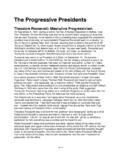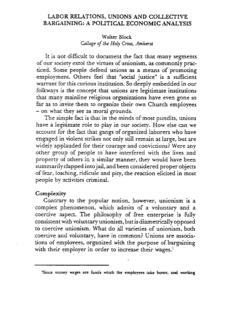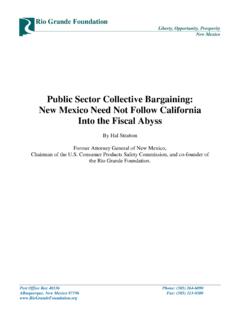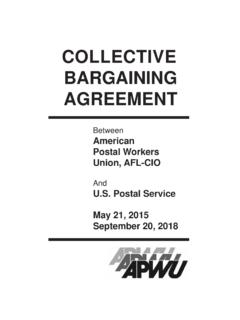Transcription of Labor Developments in the Late 19th Century - …
1 Labor Developments in the late 19th CenturyBy the 1870s the most important effect of industrialization on working people was the transformation of the skilled craftsman into a factory worker. The consequences of this change for the worker included: the loss of the bargaining power that his skills and tools had given him; the impersonality of employer-employee relations in the new corporations; and increased competition for jobs resulting from the entry into the Labor force of former slaves, women, and immigrants. For unskilled laborers weekly wages of ten dollars or less and a workday of ten hours or more were common. In addition, working conditions in factories were unhealthy and often dangerous. AIMS AND TACTICS OF MANAGEMENT AND Labor Although both management and Labor have generally wanted to see a prosperous America, they otherwise have diverging interests and goals.
2 The relationship between management and Labor creates some areas of agreement between the two, but also, and naturally, creates a conflict of interests as operators of business firms the management seek to achieve the greatest profits possible by increasing production through the most efficient use of materials and Labor . This is called the profit motive. The profit motive, in and of itself, is a good thing. Without it there is no market, no production, no employment and no goods of any value. The problem in the 19th Century was that management, as a result of a number of factors, treated workers very badly, indeed, and saw no reason to do otherwise. Factors that encouraged the poor treatment of workers included: the supply of workers outstripped demand for workers an enormous and growing pool of potential Labor gave management the all of the power in the Labor market.
3 The political class at the national level did not yet see workers as constituents, so the government was largely unsympathetic to the needs of workers. Labor unions were few and weak and not yet organized to a degree that gave them power in the economic or political employers of the late nineteenth Century distrusted attempts by workers to organize and took active measures to hinder them. Among their tactics were: the "yellow-dog" contract (a worker's agreement not to join a union during the period of his employment); the blacklist (a list circulated among employers of workers reputed to hold opinions or engage in actions contrary to the employers' interests); the injunction (an order issued by a court whereby one is required to do or refrain from doing a specified act) to restrain unions from actions harmful to employers; the open shop (an establishment in which non-union members may work); company police and company spies; use of strikebreakers (called scabs by workers) to fill the jobs of strikers.
4 1 of 7 Labor . In the latter half of the 19th Century , American workers began to organize to improve their status. The Labor movement had three principal aims: higher wages shorter hours (the common demand was for an eight-hour workday) safe and sanitary working conditions But the Labor movement was concerned with more than these goals. Among its secondary aims were: abolition of child Labor ; recognition of the principle of collective bargaining (negotiation for the settlement of terms of the collective agreement between an employer or group of employers on one side and a union or number of unions on the other); institution of compulsory arbitration of management- Labor disputes; laws providing for workmen's compensation in case of a work related accident.
5 Among the tactics of organized Labor were: the strike; picketing; the boycott; the closed shop (an establishment in which the employer by agreement employs only union members. Labor leaders were often less successful than management in mobilizing their forces. Various factors hindered Labor leaders attempts to organize workers effectively. Among these factors were: the entrance of blacks, both skilled and unskilled, into the ranks of paid Labor ,; the presence of many poorly paid women in certain crafts; the increase in numbers of foreign-born workers, divided by language, religion, and national tradition; the activities of radicals (who were often intellectuals) who wished to reorganize American society according to fanciful theories without much regard for practical difficulties, or sometimes even reality.)
6 SOME INFLUENTIAL Labor UNIONS As industrialists formed ever-larger businesses, factory workers tried to create large and strong organizations that could bargain on equal terms with employers. The mid 19th Century had seen the birth of small crafts unions that were small and largely local. These unions were no longer sufficient in an age of consolidation of American industry. Small local craft unions gave way to large national industrial unions, whose membership included workers in an entire industry irrespective of their occupation or craft. The National Labor Union. The earliest instance of bringing various craft unions into a single national organization was the establishment in 1866 of the National Labor Union, mainly through the efforts of William H.
7 Sylvis. But since many of Sylvis' s associates were allied with skilled craftsmen, they often failed to win the confidence of the factory workers. 2 of 7 OBJECTIVES. In its program the National Labor Union demanded the elimination of monopoly in industry, the establishment of a federal department of Labor , the abolition of contract Labor , the arbitration of Labor conflicts, and the enactment of laws providing for the eight-hour workday in factories. GROWTH AND DECLINE. The leaders of the union turned to politics to further their organization's objectives, entering the political field as sponsors of the National Labor Reform party. However, in the presidential election of 1872 the party made a notably poor showing, contributing significantly to the rapid dissolution of the National Labor Union.
8 The Knights of Labor . For more than a decade after the collapse of the National Labor Union, the forces of Labor were represented mainly by the Noble Order of the Knights of Labor , founded in 1869 under the leadership of Uriah S. Stephens, a tailor who had helped organize the garment cutters of Philadelphia. OBJECTIVES AND METHODS. The Knights of Labor stressed: the inclusion of all workers-skilled and unskilled, regardless of the craft or industry-in a single great organization; the formation of local assemblies of workers on the basis of their residence rather than their occupational affiliation; highly centralized control of the local assemblies by the national body. Members pledged themselves to secure for workers the full enjoyment of the wealth they create, and sufficient leisure in which to develop their intellectual, moral, and social faculties.
9 The specific objectives of the Knights of Labor included: establishing the eight-hour workday; equal pay for equal work for men and women; the abolition of Labor of children under fourteen; the prohibition of contract foreign Labor ; the arbitration of Labor disputes; the establishment of bureaus of Labor statistics on both the federal and state levels; safety and sanitary codes for industry; laws compelling employers to pay laborers on a weekly basis; the creation of cooperatives; the imposition of an income tax (meant to punish corporate wealth and pay for government support of Labor ); government ownership of railroad and telegraph lines. Although the Knights of Labor held that disputes should be arbitrated, they increasingly relied on strikes and boycotts to achieve their goals.
10 The Knights lobbied state and national governments aggressively for its program. On the other hand, the organization did not support the idea of a workers political party of the kind that was beginning to appear all over Europe. GROWTH AND DECLINE. The Knights of Labor expanded rapidly, reaching its greatest strength in 1886 when 5,892 local chapters reported over 700,000 members. However, 3 of 7a series of unsuccessful strikes in 1886 marked the beginning of the union's decline. Its complete collapse was hastened by: growing public belief that unions favored the use of violence in disputes; the hostility of skilled workers toward a union that seemed to cater to unskilled workers; the failure of most of the cooperative ventures in which the Knights of Labor had invested funds; the confusion of aims among the some radical intellectual leaders who increasingly focused on idealistic social reform measures rather than the specific Labor goals of the Knights; the revolt by many of the local assemblies against centralized control by the national body; the organization's ineffective handling of the large numbers of unskilled workers.










